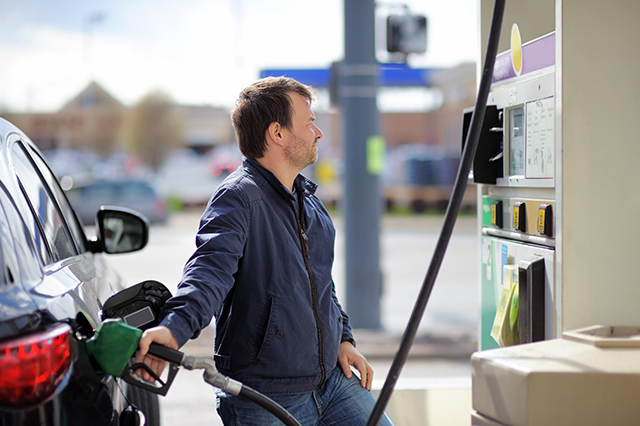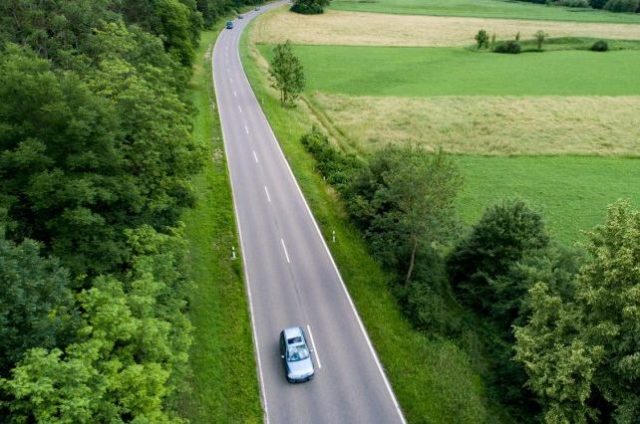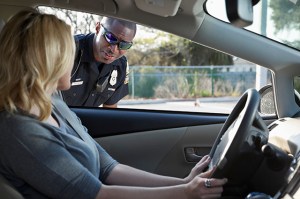Some studies suggest that using cruise control to maintain a steady rate of speed can save more gas than adjusting the speed manually, though the amount varies based on the source.
According to a Natural Resources Canada study, setting the cruise control at 49.7 mph versus wavering between 46.6 to 52.8 mph every 18 seconds uses 20% less fuel. An Edmunds’ study showed that cruise control can yield as much as a 14% savings on gas, with an average of 7%.
When it comes to hilly terrain, however, drivers often outperform cruise control.
Does Cruise Control Really Save Gas?
Based on his experience, senior manager of public affairs for AAA Northeast, Robert Sinclair Jr. said he doesn’t view cruise control as an effective way to improve fuel economy.
“From the outset, cruise control was touted as a gas saver by maintaining a constant speed and avoiding the gas guzzling on-the-gas, off-the-gas driving style of those in a hurry,” Sinclair said. “Skeptics said ‘not true’ if a lot of hills were involved since maintaining a given speed on a steep incline would use more fuel.”
Sinclair said his first experience with the feature was in 1985 while driving a 1982 Mazda 626 with a manual transmission. He too wondered if cruise control saved gas but found it difficult to get an accurate analysis.
“Calculating mileage was hit or miss, relying on the fuel gauge to calculate gallons burned between full and half-full,” Sinclair said. “My mileage always seemed much lower than what the car was supposed to achieve. I noticed that in certain situations, the engine screamed to high [revolutions per minute] to get back to the selected speed. How can that save gas? Also, since cruise control is almost always used on the highway, would it make a difference if used with closed windows and air conditioning or with open windows and the A/C off? It was difficult to tell.”

Planning a road trip? Want to compare the costs to fly or drive? Visit AAA Gas Prices for a road trip planner gas cost calculator that you can use to find out how much you will spend on gas during your next driving trip or vacation.
Consumers long have complained about vehicles falling short of the amount of money they anticipated saving on gas while using cruise control, according to Sinclair.
On a recent drive from Detroit to New York, Sinclair once again pondered the gas-saving effectiveness of his cruise control. “The query came to mind as the vehicle I had did all sorts of crazy things while the cruise control was activated as another new system, collision braking, intervened to supposedly prevent crashes,” he said. “The cruise control tracked vehicles in front to slow down if we got too close. It seemed to track cars in an adjacent lane, so when I changed lanes to one with no cars in front for miles, the vehicle inexplicably started breaking hard. It got so bad that I worried I was going to get hit in the back when the wayward system started applying the brakes for no apparent reason. And this saves gas? I switched the system off and drove the way my grandfather learned.
“Having little opportunity to use it and modern systems complicating it to the point of frustration, my answer would be a resounding ‘no,’” he said.
How Cruise Control Works
Like a human driver, the cruise control manipulates the speed of the car by adjusting the throttle position, but instead of pushing a pedal, a mechanism called an actuator controls the throttle when cruise control is engaged. Both the cruise control and the accelerator are attached to the throttle with a cable. Both cables move when cruise control is on, which is why you might see your gas pedal move when cruise control is engaged.
The throttle controls the speed by regulating how much air is taken in by the engine. A small computer behind the dashboard or under the hood controls the cruise control. The computer is connected to the throttle controls and other sensors. Cruise control will automatically disengage when the driver hits the brakes.
Most controls have on and off buttons, as well as accelerate and decelerate buttons, which let you increase or decrease your speed by 1 mph. Some cars also have a coast button, which lets you decelerate while you hold the button down and resume your cruise speed when you release it.
The Next Generation of Cruise Control
Recently, automakers introduced autonomous cruise control or adaptive cruise control. Not only do these systems maintain a speed set by a driver, they also automatically maintain a safe distance from any vehicles ahead, braking when they get too close and resuming the cruising speed when it is safe to do so. Does it save gas? Well, some of these features can certainly help.
Cruise control systems can vary in design quality. The true test is when the car ascends a hill. A good system will not deviate the speed of the car too much during an uphill climb and it won’t overshoot the power it needs to maintain the necessary speed, either.
The fuel economy benefits of cruise control come from the system minimizing throttle openings, like when a driver lifts his or her foot off the accelerator a dozen times during a 10-minute drive. Therefore, a cruise control system that struggles on hills is not maximizing its ability to conserve fuel. However, with different systems in different vehicles, you are likely to see different results with almost every car model you drive.
What do you think? Does cruise control save gas in your vehicle when you’re driving? Share your thoughts in the comment section below.
This article has been updated and republished from a previous version.
22 Thoughts on “Does Cruise Control Save Gas?”
Leave A Comment
Comments are subject to moderation and may or may not be published at the editor’s discretion. Only comments that are relevant to the article and add value to the Your AAA community will be considered. Comments may be edited for clarity and length.

















I’ve been using cruise control since about 1985. I drive a lot and it mitigates nerve pain in my foot. I use CC everywhere. On long highway trips, I get 34-36 mpg in my 2015 Subaru Outback, depending on the gas I use. I usually set CC at five mph over the speed limit, but rarely go over 70. On the hilly, rural roads at home, I get 28-29 mpg. I cruise at a speed that can accommodate road curves without braking. I get an overall average of 30 mph. Both local and highway, I assist with acceleration on hills. I can’t prove I am saving gas; but my usage is better than the manufacturer publishes. I love cruise control. It takes so much emotion out of driving because I am not having to interact (virtually) with every driver on the road. It’s fabulous when everyone is using it on the highway and uses lanes properly. Adaptive CC is even better, safer. CC frees up brain space to pay attention to the road better.
Cruise Control Pet Peeves: Both involve downshifting. Going up a hill the CC will over compensate and downshift and go into high RPMs. It does the same when I”m in a I decide to go faster and don’t slowly increment the speed or if I’m using adaptive and behind a car and decide to switch lanes to get around them because I”m now doing far slower than the speed limit or what I have CC Set at, the car will downshift and rapidly accelerate. If I’m going the driving on those situations I’m probably not downshifting and slowing increasing the speed, or going up the hill allowing the car to drop a bit below my desired speed.
One funny thing with adaptive is that I often get lulled and end up behind cars for a bit before I realize I’m going slower than I want to. LOL
But when I’m outside of those high rev situation it seems CC gets me 2-3 mpg more over a tank
I love cruise control. Especially in my manual transmission Hyundai Accent. It won’t shift on me at highway speeds. I don’t care about gas savings cause it’s good on gas already. I do a lot of driving and it helps with long drives. All my other cars/van have regular cruise also and it just makes driving that much more enjoyable to me. However, we now inherited my dad’s sienna that had adaptive cruise and it was cumbersome. Now it only works in regular mode after you set it before you put the car in drive. Good topic. Thanks for the shares.
I have adaptive cruise control in my car and I think it has advantages and one big disadvantage.
Positives:
I can set my car to travel 1,2,3 or 4 car lengths behind. It will automatically accelerate or decelerate to maintain the distance. 1-car length is more like 1-1/2 car lengths, so people in back are always passing me.
The automatic breaking is great for safety sake because it can prevent a rear end collision. For this reason alone, I believe EVERY vehicle needs this ASAP. In fact, my car can come to a complete stop in bumper to bumper traffic, start and stop, etc., without me doing a thing. The lane assist keeps me in my lane too.
Negative:
The major negative is it’s always hitting the brakes. It will approach the car in back and then apply the brakes to maintain the distance. On the freeway, it is always hitting the brakes which ends up wearing your brake pads own faster. They need to improve this because it’s more than about gas savings. What good is saving a few bucks on gas when you need to spend a ton of money on new pads and rotors. They need to fix it so that it can somehow let up on the gas when it sees a car ahead instead of the gas/brake, gas/brake, gas/brake.
All in all, I won’t buy a car that doesn’t have adaptive cruise control with lane assist. Period. I just hope they address the issue I mentioned.
2019 Lexus RX350 (Radar Cruise)
2020 GMC Terrain (Adaptive Cruise)
2022 Chevy Colorado (Regular Cruise)
I have used both regular & adaptive cruise on 3 vehicles in the last few years. Different “adaptive” systems seem to work differently. Some actually apply the brakes going down hill, or if I manually adjust the speed “down” in quick increments. This happens on the Lexus. This practice did not happen on the Terrain or the Colorado. The General Motors cruise system seem to let you freewheel where the Lexus seems to apply the brakes.
Living in Florida, the roads are pretty flat (except going over other roads at interchanges).
I adjust the speed on the Colorado, only when necessary. I usually change lanes to maintain speed.
With the Lexus, I usually do not use the Radar Cruise because too many people change lanes in front too closely triggering the Cruise Bot to slam on the brakes, as well as if I change lanes abruptly. This is counter productive. I use regular cruise as with the Colorado.
I usually only use the Lexus Radar Cruise in really heavy traffic, 20-40 mph. But, there is still a problem with this when the car in front take off quickly, causing the Lexus to “jack rabbit” only to hit the brakes 1/4 mile ahead. I have realized, it’s best to turn down the Set Speed so that it won’t try to jack rabbit up to 60, I usually set it down to 35 or so, and then adjust accordingly.
I read an article a few years back which made me change my cruise driving habits. Now, I usually disengage in very hilly areas. A smooth acceleration up a hill, (maybe going gradually slower on the incline is smoother than the “cruise bot” mashing down on the accelerator.
Mainly, I believe it saves on Long Trips, but Only if you adjust accordingly. Reducing fatigue while on a long trip helps to keep a consistent speed where it might be harder using the old right foot. Especially flatter roads
I had a Subaru Impreza, I used the 25mph at cruise control in town in light traffic. And in highways, whenever feasible. My Toyota Corolla can not do Cruise Control at 25MPH. If I knew, I would not have gotten the Corolla. I could just drive and not have to watch the speedometer all the time.
I don’t know. Cruise Control—It sounds like a case of taking the driver for a ride. I don’t trust it, to be honest.
Braking is a big factor. The more you can maintain speed and, when necessary, coast and soft brake to an anticipated slowdown the better. My old driving school teacher said to pretend there was an egg between your foot and the accelerator pedal.
We have a 202 Nissan Altima with afaptive cruise control. The user manual says to use the cruise control to get better milage. Modern adaptive systems work very well.
I bought my (manual shift) 2018 Subaru WRX as a new car. I use cruise control at every opportunity. Logging about 68,000 miles of driving thus far, I have averaged 28.8 mpg. Subaru states that this car averages 24 mpg. Subaru also states that if this car were driven only on highways, which it hasn’t, it would average 27 mpg.
Do brake lights come on when the cruise control causes car to brake?
It does. The vehicle image on the dashboard of my 2016 Subaru Outback shows red lights going on at the back of the car when it slows down and, to be certain, I’ve asked friends to follow me and tell me the moment they see my brake lights come on. It does, the instant dynamic cruise control activates.
I’m a snowbird taking the long ride up and down the East Coast from Jupiter, Florida to Virginia Beach and on to Manheim, Pennsylvania and Rhode Island. I use cruise control whenever I can. I usually set it at 7-10 mph over the posted limit. On a good trip outside major cities, I’ve gone for long stretches without touching the gas or brake pedals. I find cruise control gives me a 2-5 mpg better result than the advertised gas consumption numbers on the cars I drive. The car is smarter than I am and , in my opinion, saves me money.
Comparison of with and without cruise control has become simpler with ev energy use monitoring.
Cruise control saves energy in all road settings.
How much? I will leave calculations to engineers.
From my perspective it’s obvious.
Good article and good comments from readers. Yes, the final answer is “it depends”. For our Honda Accord I’ve found that cruise control (CC) fails to adjust to driving up and down of hills in the same way I can do manually. When going down hill I can let up on the gas and just before going back up I can slightly accelerate so when going up it can maintain the speed I want. With cruise control as you decend the system puts on the brake, slows you down and then as you begin up hill it has to accelerate a lot to get back to speed. At that point it seems to be wasting gas. I can avoid that manually because the human brain can anticipate and the CC does not. Having said that I prefer CC on long highway trips because driving manually takes more mental work (focus) on how I’m driving and actually takes some mental attention away from traffic events. I have fewer things do do while driving which I think makes it safer. (But I also agree with the reader who mentioned you can work with CC while driving hills to make adjustments that will save you fuel.)
Using your brakes as little as possible can definitely save gas. Keeping cruise control to a speed where you don’t have to constantly adjust your speed probably helps, but guessing that using adaptive cruise and setting the speed high enough that the system constantly adjusts the speed and use the brakes doesn’t save gas.
Thank you for the thought provoking conversation. Similar to many complex questions, and as suggested by the responses so far, whether cruise control saves fuel “depends” on many factors. In fact, I believe a combination of cruise control/driver involvement yields the best results and keeps the driver engaged. For example, using cruise control and, if traffic conditions allow, reducing speed as I ascend hills and picking up speed going down hills, all within the speed limit, of course, seems to work best for me, and prevent the downshifts going up or down hill provided by modern cars.
For example, with the cruise set at 65, use the coast button to slow to 60 MPH up hill and accelerate up to 70 down hill. Best case — use the down hill momentum to get up the next hill — follow the example of the truckers.
Even straight up, as long as the car does not accelerate hard, and some do, cruise saves fuel.
The best reason to use cruise control — to eliminate speeding tickets, especially in 30, 40 and 45 MPH zones.
Does it provide better gas mileage, yes and no. If you are on a major four lane highway and the terrain is pretty flat and there is not a lot of traffic, you can get better mileage as the car versus the driver is controlling the speed. I check recently on a 6 hour drive, one way cruise, the other without cruise, the terrain had a lot of hills. What the difference between the trips was less without cruise mostly because I could better control slowing down when traffic backed up as my foot had better control of the speed versus the cruise button, both slowing down and speeding back up. But then I have been driving for a long time, so that may have something to do with it.
Using Cruise Control in my 2013 Honda Accord saves gas. Trips to my house at Cape Cod, 110 miles one way, I had many opportunities to check my mileage with or without Cruise Control. On average I got 42MPG with cruise control, 38-39 MPG without, with speed set at 10MPH above the speed limit.
I believe that cruise control does improve your mileage. having said that, the improvement if any depends upon many factors. In highway driving with light traffic on a long trip ( and maintaining a speed no greater than 65 MPH) the potential gains are surely there. Now add in heavy traffic requiring much breaking for cars in front, not so much. Hills of course also have an effect, but mostly because of cars in front not using cruise control slowing down and forcing you to also slow down or worse speed up to now go around them. In any event, cruise control makes a long trip much less stressful and is well worth using.
I have owned vehicles with and without cruise control, both standard shift and automatic. I currently own a Jeep Patriot with a 5 speed standard transmission.
I like it. Out of high school I owned a 1962 Grand Prix with an automatic transmission. As I was contently under the hood in those days, I installed and after market cruise control system to this GP. I fell in love with this feature after my initial first weekend of trying it out.
I personally feel more comfortable driving long trips, using cruise control. I truly DO believe that it saves fuel. When not using cruise control I found that I would continuously have to adjust my speed (more often to speed up) while driving. With the cruise control on, I am set to the correct speed and not having to monitor my speedometer keeps me more focus on the road ahead. I also find that planning the trip is easier as the time calculation is usually right on even when calculating rest and fuel stops for that trip. I also get my highest MPH figures when using cruise control on open road trips. Using it as recommended by the mfg. is a great feature.
I disagree with the Sinclair’s analogy that cruise control does not reduce fuel consumption. I have a 2008 Camery SLE and Whenever I have long distance drives and use the Cruise Control, I get close to or over 30mph.